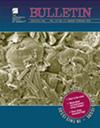风化如何影响古元古代带状铁地层的地球化学指标?西澳大利亚哈默斯利盆地2.46 Ga条带状铁组露头样品研究
IF 3.9
1区 地球科学
Q1 GEOSCIENCES, MULTIDISCIPLINARY
引用次数: 0
摘要
带状铁地层中痕量金属和稀土元素丰度的测定对于评估古海水的化学成分和海洋-大气系统的长期演化具有重要意义。然而,最近的研究强调了露头风化的潜在影响,引起了人们的关注,即带状铁地层样本是否适合用于古代氧化还原条件,或者暴露于地表风化制度是否可能改变关键的地球化学信号。在这里,我们对来自西澳大利亚哈默斯利盆地的几个带状铁地层露头样品进行了详细的、高分辨率的研究,以研究带状铁地层和风化表面(即风化壳)之间成分的微观差异。元素填图和块状岩石地球化学分析表明,风化地壳中除二氧化硅明显减少外,大多数元素都比带状铁构造富集。风化表面氧化还原敏感元素(RSEs)也有显著的损失,这表明露头样品受到的化学浸出程度高于物理侵蚀程度。这些结果意义重大,因为我们清楚地表明,风化表面的地球化学特征——不管它是如何形成的——与样品的其余部分不同。这意味着,通过对样品的充分筛选,发现明显的蚀变迹象,带状铁地层露头样品确实可以作为地球海洋-大气耦合系统演化的可靠代表。这增加了容易获得的前寒武纪样品材料的数量,因此研究人员不再仅仅依赖于通过昂贵的钻探计划回收的岩心。本文章由计算机程序翻译,如有差异,请以英文原文为准。
How does weathering influence geochemical proxies in Paleoproterozoic banded iron formations? A case study from outcrop samples of 2.46 Ga banded iron formation, Hamersley Basin, Western Australia
Trace metal and rare earth element (REE) abundances in banded iron formations are critical for assessing the chemical composition of ancient seawater and the long-term evolution of the ocean-atmosphere system. Recent studies, however, have highlighted the potential effects of outcrop weathering, raising concerns about whether banded iron formation samples are suitable proxies for ancient redox conditions or if exposure to surficial weathering regimes may have altered key geochemical signals. Here, we present a detailed, high-resolution study of several banded iron formation outcrop samples from the Hamersley Basin, Western Australia, to investigate microscale differences in composition between banded iron formation and weathered surfaces (i.e., weathered crusts). Elemental mapping and bulk-rock geochemical analyses reveal that weathered crust is more enriched in most elements than the banded iron formation, except for silica, which is significantly depleted. There is also a significant loss of redox-sensitive elements (RSEs) in the weathered surface, which suggests that outcrop samples have been affected by higher degrees of chemical leaching than physical erosion. These results are significant, because we clearly show that the geochemical characteristics of the weathered surface—irrespective of how it formed—are distinct from those of the remainder of the sample. This means that with sufficient screening of samples for obvious signs of alteration, banded iron formation outcrop samples may indeed be used as a reliable proxy for the evolution of Earth’s coupled ocean-atmosphere system. This increases the volume of easily accessible Precambrian sample material, so that researchers no longer solely need to rely on core recovered through costly drilling programs.
求助全文
通过发布文献求助,成功后即可免费获取论文全文。
去求助
来源期刊

Geological Society of America Bulletin
地学-地球科学综合
CiteScore
9.30
自引率
8.20%
发文量
159
审稿时长
4-8 weeks
期刊介绍:
The GSA Bulletin is the Society''s premier scholarly journal, published continuously since 1890. Its first editor was William John (WJ) McGee, who was responsible for establishing much of its original style and format. Fully refereed, each bimonthly issue includes 16-20 papers focusing on the most definitive, timely, and classic-style research in all earth-science disciplines. The Bulletin welcomes most contributions that are data-rich, mature studies of broad interest (i.e., of interest to more than one sub-discipline of earth science) and of lasting, archival quality. These include (but are not limited to) studies related to tectonics, structural geology, geochemistry, geophysics, hydrogeology, marine geology, paleoclimatology, planetary geology, quaternary geology/geomorphology, sedimentary geology, stratigraphy, and volcanology. The journal is committed to further developing both the scope of its content and its international profile so that it publishes the most current earth science research that will be of wide interest to geoscientists.
 求助内容:
求助内容: 应助结果提醒方式:
应助结果提醒方式:


